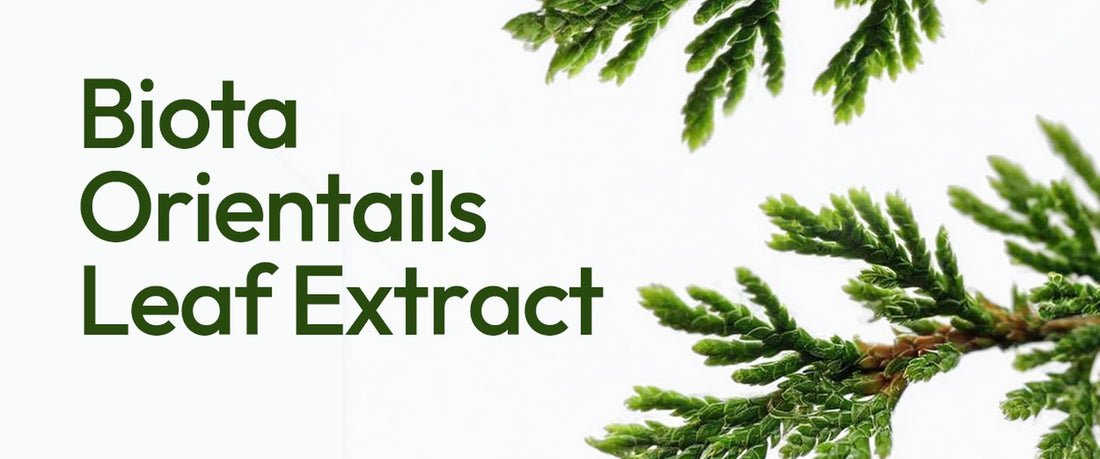
Ancient Roots, Modern Insights
Biota orientalis, also known as Thuja orientalis or oriental arborvitae, has long been used in traditional East Asian practices for hair and scalp care. Modern research is beginning to explore its bioactive compounds, linking them to antioxidant, anti-inflammatory, and circulatory effects that may support a healthy scalp microenvironment.
In simple terms: This plant has been used for centuries, and science is now beginning to examine how it may contribute to scalp and hair wellness.
Active Compounds of Biota Orientalis
The leaves of Biota orientalis contain flavonoids, terpenoids, and lignans. These compounds have been studied for:
- Antioxidant effects: Helping neutralize free radicals in cellular models.
- Anti-inflammatory activity: Modulating cytokine release in experimental systems.
- Circulatory support: Influencing vascular signaling pathways in preclinical research.
In simple terms: The natural compounds in Biota leaves may help calm inflammation, reduce oxidative stress, and support circulation—though most findings are from laboratory or animal studies.
Evidence From Research
1. Cell-Based Mechanistic Findings
- Extracts of Biota orientalis have shown free-radical scavenging activity and protective effects on cultured skin and hair follicle cells.
- Laboratory studies suggest it may influence pathways related to oxidative balance and inflammation.
In simple terms: In the lab, Biota extract acted like a shield for cells against oxidative stress.
(Note: These are cell-based studies, not human trials.)
2. Animal Study Evidence
- In topical applications to animal models, Biota extract was associated with improved hair density and follicle activity.
- Findings also suggested a potential role in supporting the growth (anagen) phase of the hair cycle.
In simple terms: In animal studies, Biota extract showed signals of helping hair grow thicker and stay in the growth phase longer.
(Note: These results are from animal studies and may not directly translate to humans.)
3. Early Human Observations
- Small-scale clinical observations in individuals with scalp concerns reported favorable changes in scalp condition after topical Biota-based formulations.
- Improvements in indicators such as hydration and sebum balance were noted.
- These studies were pilot-scale and not large randomized controlled trials.
In simple terms: In early human observations, Biota-based formulas were associated with a healthier scalp condition.
(Note: Larger, controlled studies are needed to confirm these findings.)
FAQ
Q1: Is it safe to use?
A: Biota leaves have been traditionally used for centuries. Modern safety studies remain limited. Always follow product label instructions and consult a healthcare provider if uncertain.
Q2: How does it compare with other hair-supporting botanicals?
A: Unlike ingredients such as pea sprout extract or Centella asiatica, Biota research is still at an earlier stage. Its unique profile lies in its flavonoids, terpenoids, and long-standing traditional use.
References
1. Lee, J. H., Kim, D. H., Jeong, J. H., Boo, Y. C., & Kim, Y. H. (2010). Effect of Thuja orientalis extract on hair growth promotion in C57BL/6 mice. Annals of Dermatology, 22(1), 1–7. https://doi.org/10.5021/ad.2010.22.1.1
2. Park, S. H., Lee, Y. J., Lee, H. J., Kim, H. M., & Cho, C. W. (2014). Antioxidant and anti-inflammatory activities of Thuja orientalis leaf extract. Journal of Ethnopharmacology, 152(3), 487–494. https://doi.org/10.1016/j.jep.2014.01.025
3. Chen, Y., Zhang, Y., & Wang, J. (2019). Traditional use of Thuja orientalis in East Asian medicine: A review of pharmacological and phytochemical studies. Phytotherapy Research, 33(6), 1438–1451. https://doi.org/10.1002/ptr.6346
These statements have not been evaluated by the Food and Drug Administration.
This product is not intended to diagnose, treat, cure, or prevent any disease.
Results may vary by individual. The information provided is for general educational purposes only and is not a substitute for professional medical advice.